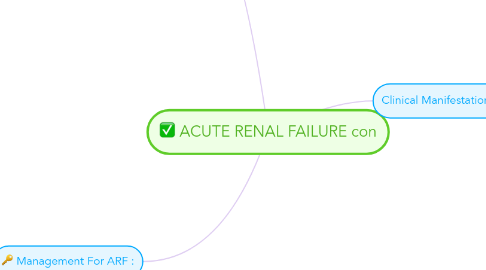
1. Nursing Diagnoses
1.1. Fluid Volume Excess related to decreased glomerular filtration rate and sodium retention
1.2. Risk for Infection related to alterations in the immune system and host defenses
1.3. . Altered Nutrition (Less than Body Requirements) related to catabolic state, anorexia, and malnutrition associated with acute renal failure
1.4. Risk for Injury related to gastrointestinal bleeding
1.5. . Altered Thought Processes related to the effects of uremic toxins on the central nervous system (CNS
2. Management For ARF :
2.1. A.Preventive Measures :
2.1.1. Identify patients with preexisting renal disease.
2.1.2. . Initiate adequate hydration before, during, and after operative procedures
2.1.3. . Avoid exposure to various nephrotoxins. Be aware that the majority of drugs or their metabolites are excreted by the kidneys
2.1.4. Avoid chronic analgesic abuse—causes interstitial nephritis and papillary necrosis.
2.1.5. . Prevent and treat shock with blood and fluid replacement. Prevent prolonged periods of hypotension
2.1.6. . Monitor urinary output and central venous pressure hourly in critically ill patients to detect onset of renal failure at the earliest moment.
2.1.7. Avoid infection; give meticulous care to patients with indwelling catheters and IV lines.
2.2. B.Corrective/Supportive Measures
2.2.1. Correct any reversible cause of acute renal failure (eg, improve renal perfusion; maximize cardiac output; surgical relief of obstruction).
2.2.2. . Be alert for and correct underlying fluid excesses or deficits.
2.2.3. Correct and control biochemical imbalances—treatment of hyperkalemia.
2.2.4. . Restore/maintain blood pressure.
2.2.5. Maintain nutrition.
2.2.6. Initiate hemodialysis, peritoneal dialysis, or continuous renal replacement therapy for patients with progressive azotemia and other life-threatening complications.
